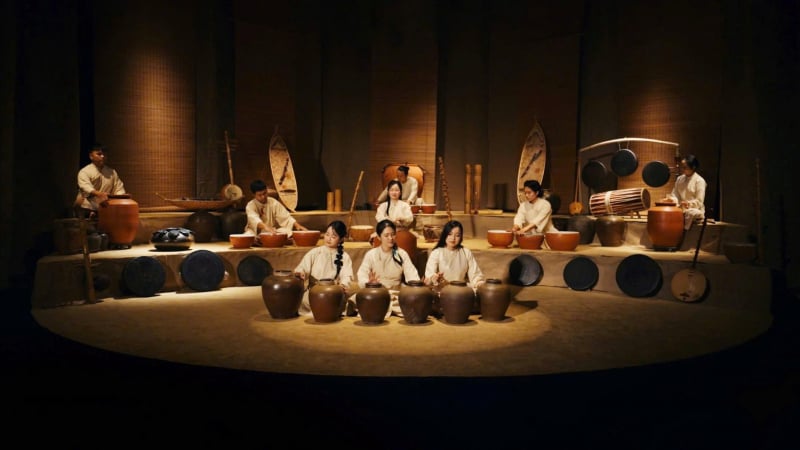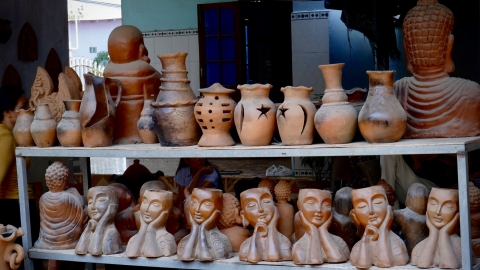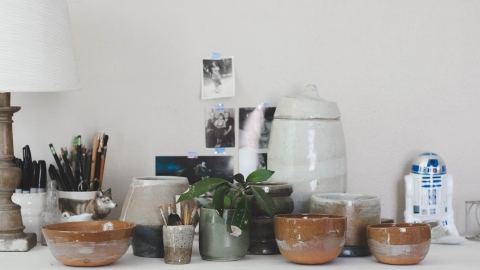From small shop to garden of a ceramic ecosystem
About ten years ago, this garden was just a small shop specializing in selling ceramics. Each bowl, vase, jar, jar... was brought from Binh Duong or Bien Hoa by waterway, then spread throughout the Saigon market. Over time, the shop grew, built its own workshop, and expanded into a garden of more than 1,800 m² - a place that recreates a part of the memory of the land that was once bustling with boats carrying ceramics back and forth.
Amid the year-round hot and humid sun of the South, the garden is covered with green trees, providing shade. A gravel path leads visitors to the exhibition area, where the ceramic handicrafts are meticulously arranged like an outdoor exhibition. Eel-skin glazed vases, crackle-glazed bowls, blue-glazed vases, and hundreds of simple but sophisticated household items are all handcrafted and finished by the artisans in the workshop.

Green space and gravel path leading to the garden

True to its name, every corner here displays ceramic products, with a variety of colors and genres.
The space here is divided into many areas: the area for selling finished products, the workshop area, the workshop - the artisans' workplace, and the area for displaying products during events. The open layout allows visitors to both visit and experience the pottery making process: from molding clay, glazing, firing to painting patterns. Next to it is the Pottery Garden grocery counter, arranged like an old store: old wooden cabinets, candy, cakes, juices and a glass box for customers to pay by themselves, a cute feature reminiscent of the subsidy period.

Old-fashioned self-service grocery store in the middle of the garden
When three ceramic lines tell the story
The vitality of the garden comes from the “Thu Bien workshop” area, a name combining Thu Dau Mot and Bien Hoa - two lands that produce famous Southern ceramic lines. There, artisans are diligently coloring, drawing patterns, and glazing each product. Ms. Yen, who has been involved in Lai Thieu ceramics for more than half a century, is meticulously painting Santa Claus and reindeer on Christmas cups. In the other corner, another artisan is decorating piggy banks with brilliant green, red, and yellow glaze.


Artisans meticulously paint glaze for ceramic products in the workshop
From the workshop, the items associated with the lives of Southern people: rice bowls, plates, water bottles, jars... of Lai Thieu pottery are displayed in the Lai Thieu bowls and dishes area, surrounded by green bamboo bushes rustling in the sun. The glaze of Lai Thieu pottery has a rustic yet sophisticated look, many products are covered with white, brown, green or eel skin glaze, with floral, bird, and carp motifs, bringing a close and familiar feeling. Each bowl and vase seems to retain the breath of the over-100-year-old pottery kilns on the Saigon River.



Typical Lai Thieu ceramic products are still being produced at the factory.
Opposite is the ceramic zoo, where hundreds of ceramic models simulating animals are arranged in a fun way. From buffaloes, cows, pigs, chickens... familiar animals in daily life to foxes, elephants, horses, birds, turtles... all have cute, eye-catching appearances. Under the sunlight, the ceramic glaze shines in blue, brown, and golden colors, making each animal seem alive and dancing in the eyes of the viewer. This is also an area that attracts many families with young children, where they can both admire and touch the colorful "terracotta friends".



Ceramic animals are displayed in a separate area, attracting young visitors.
Not only for display, the garden is also a place to preserve and promote the traditional techniques of three pottery lines: Lai Thieu, Bien Hoa and Cay Mai. Each line has its own "personality", creating an interesting dialogue between the products. Lai Thieu pottery is rustic, close, and full of folk breath; Bien Hoa pottery is sophisticated, rich in aesthetics and unique blooming glaze technique while Cay Mai pottery has an ancient, nostalgic look, reminiscent of old Saigon with a warm glaze color palette.
These elements are cleverly combined, both preserving the traditional spirit and bringing a contemporary breath through design and usage. Many products are modified: from bowls, vases, glasses, plates to decorative objects such as masks, animal statues, ancient house models, reliefs... creating a vibrant and diverse ceramic ecosystem.

Color chart of ceramic glazes in the workshop

The ceramics are displayed together, creating an interesting dialogue of traditional craft amidst contemporary life.
The flow of tradition and creativity
What makes this garden different is not only the green space or the scale of production, but the way they respect and renew the heritage of Southern ceramics. Seemingly separate ceramic lines meet here in a “meeting” of glaze and soil.
Lai Thieu pottery originates from Binh Duong, famous for its durability, diverse glazes and rustic motifs. This pottery line used to be a symbol of daily life: water jars, earthen pots, bowls used in the kitchen. Through the hands of artisans, they have a simple yet familiar appearance, something "beautiful enough" to use every day but can still be placed on a decorative shelf.

Ceramic garden area dedicated to Lai Thieu ceramic products


Bien Hoa pottery, on the other hand, tends towards fine art. This pottery line is influenced by European art and modern decorative styles from the early 20th century. The “flowering bronze green” glaze - a characteristic unique to Bien Hoa, creates a deep jade green color, turning each product into a work of art. In the garden, this pottery line appears in engraved vases, decorative statues or glossy glaze vases, demonstrating the sophistication and sophistication of the firing technique.


Turquoise color and engraving technique are typical of Bien Hoa pottery.
Cay Mai pottery, an ancient pottery line of old Saigon, was once associated with the famous “Pottery Lo Gom Hamlet”. This pottery line uses a dark glaze palette: blue, brown, black, earthen yellow, with few colors but rich in emotions. The products are often statues, reliefs, bonsai pots, or worship items - things that were once present in pagodas, ancient houses in the South. Although rarely produced today, Cay Mai pottery still retains its collectible value and is recreated by the garden in restored models, so that young people know that Saigon once had its “own pottery line”.

Nowadays, Cay Mai pottery is produced in smaller quantities but has high collectible value.
The interesting thing is that when these three ceramic lines appear together, viewers can easily recognize the harmony of styles: simple Lai Thieu glaze is decorated with sophisticated Bien Hoa motifs; the classic Mai tree color becomes bright when placed in the open space of the garden. All blend together, like a new flow, both preserving traditional roots and expanding creativity.
The land tells stories of people
Coming to the workshop area, visitors can mold clay, paint glaze, and create their own products. These works, from scribbles to round ceramic vases, are displayed in the common space, showing the diversity of visitors: some come just to relax, some to find creative inspiration, and some simply want to touch the memories of their childhood with old water jars and ceramic rice bowls. Each vase and each ceramic statue bears a personal mark.


Some products of guests experiencing the workshop are displayed in a wooden cabinet.
In the garden, the sound of brushes, laughter and the smell of baked clay blend together. The workers diligently pack the products, while the artisans are busy glazing and painting designs. Here, pottery is not just a production, but a journey of telling stories with clay, each product is a separate story about the craftsman, the fire, and the land that gave birth to it.




On weekends, many visitors with children come to experience the pottery garden.
Leaving the garden, holding a white-glazed Lai Thieu bowl or a small ceramic turtle from Bien Hoa, one seems to carry with them the smell of soil and the fire of the South. In the midst of a modern city where everything can be replaced by plastic or metal, ceramics still retain their old value, both useful and soulful. And this garden, with patience and love for the craft, is silently preserving that soul - the soul of soil, of fire, and of the hands that make ceramics without rest.

 EN
EN



































